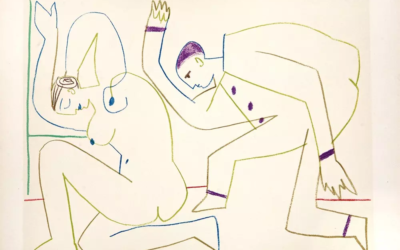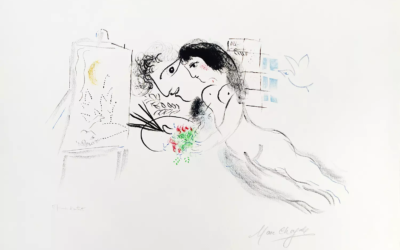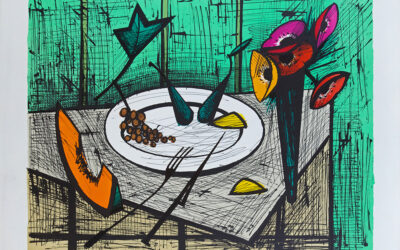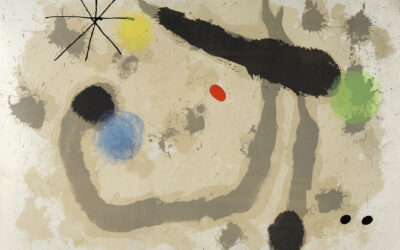
Jean-Baptiste Sécheret, Brindisi fond ocre, 2004, monotype en couleurs rehaussé.
La technique du monotype
Le monotype est une technique artistique assez peu connue du grand public, mais au combien inspirante pour les artistes. Ce procédé d’impression faisant appel à la spontanéité est un art à part entière, qui a été pratiqué par de grands noms de l’histoire de l’art.
La technique du monotype donne lieu à des œuvres d’art uniques avec des effets étonnants que l’on ne peut obtenir autrement. Les artistes peuvent expérimenter avec différentes textures, couleurs et effets pour créer des impressions originales qui capturent leur vision artistique. En raison de la nature unique de la pratique, ces œuvres expressives sont très appréciées par les amateurs d’art et les collectionneurs chevronnés qui recherchent des pièces uniques et rares.
Qu’est-ce qu’un monotype ?
Un procédé d’impression sans gravure
La technique du monotype est une technique d’impression d’art sans gravure qui produit un tirage unique. Ce procédé combine des éléments de dessin, de peinture et d’impression. Cette méthode consiste à obtenir une estampe à partir d’une image tracée sur une surface non poreuse, généralement une plaque de verre ou de métal, en appliquant de l’encre ou de la peinture. Il s’agit alors d’une impression unique, d’où le nom monotype, obtenue par la pression du papier contre la plaque.
Contrairement à la technique de la gravure, ce processus créatif se réalise sans avoir à ciseler ni entailler la plaque. L’image est directement réalisée sur la plaque recouverte d’un médium approprié (encre, peinture acrylique ou à l’huile), qui sera ensuite transférée sur le papier, soit à l’aide d’une presse d’impression ou d’une pression manuelle. Le monotype donne lieu à une impression unique, c’est donc une œuvre originale.
Quels matériels sont utilisés ?
Le monotype est un procédé de création qui nécessite un support rigide tel qu’une plaque de verre, métal, plexiglas ou encore carton fort. Pour réaliser une estampe en monotype, on utilise le plus souvent l’encre d’imprimerie grasse ou à l’eau, la peinture à l’huile, la gouache ou l’acrylique. Selon la manière dont il est utilisé, un même médium peut créer divers effets.
La différence avec les autres types d’estampes
Ce qui distingue le monotype des autres techniques d’impression, telles que la gravure sur bois, la lithographie ou encore l’eau forte où plusieurs impressions identiques peuvent être réalisées, c’est qu’il produit un seul exemplaire de l’œuvre d’art. Le résultat est souvent caractérisé par des effets de transparence, des traits fluides et une qualité imprévisible, ce qui confère au monotype un caractère unique et spontanée.
En effet, avec ce procédé d’estampe (nos estampes à Paris) , l’artiste peint sur la matrice, mais ne découvrira son œuvre qu’après impression sur le papier. Il est également possible de tirer une deuxième estampe, appelée une impression « fantôme », qui est réalisée avec le résidu d’encre sur la matrice. Celle-ci sera donc beaucoup moins forte que la première épreuve, étant parfois une simple trace de l’œuvre originale.
Les origines du monotype
La technique du monotype a été inventée par Giovanni Benedetto Castiglione durant le XVIIe siècle qui a réalisé de nombreux monotypes religieux. Presque oubliée, la technique du monotype est redécouverte par Edgar Degas au XIXe siècle, qui la popularise, en particulier auprès des impressionnistes. Il explore de nouvelles possibilités créatives avec la réalisation de fonds riches en couleurs, remplis de textures et de mouvements, qu’il sublimera au pastel.
Le monotype a connu une popularité croissante parmi les artistes modernes au fil du temps, notamment des artistes de renom tels que Paul Gauguin, Camille Pissarro, Pablo Picasso, Henri Matisse. Aujourd’hui, le monotype continue d’être pratiqué par de nombreux artistes contemporains, à l’exemple de Jean-Baptiste Sécheret, qui explorent cette technique et l’adaptent à leur style et vision artistique.
La technique du monotype à l’épreuve de la créativité
Une forme d’expression individuelle
En raison de sa nature spontanée et expressive, le monotype laisse place à une grande liberté artistique et expérimentale. Ce procédé d’impression permet des envolées créatives à plusieurs niveaux qui accentuent le caractère unique d’un monotype : de l’outil à la plaque, en passant par le type d’encre ou l’ampleur des mouvements. Les artistes sont libres d’utiliser une variété de techniques pour créer des effets différents, tels que l’application de l’encre avec des pinceaux, rouleaux, chiffons ou autres objets détournés qui laissent leurs empreintes dans le médium utilisé.
Cette richesse infinie d’expression permet des résultats très variés, allant d’une image abstraite à une représentation figurative détaillée. Avec la technique du monotype, l’œuvre comme ses effets ne se fixent que lors de l’impression, laissant à l’artiste de nombreuses possibilités créatives.
Des débouchés créatifs infinis
Avec le monotype, l’artiste ne peut pas anticiper le résultat de son œuvre. À ce titre, la découverte du résultat imprimé peut s’avérer parfois décevante, mais l’artiste peut revenir sur son épreuve et la retravailler avec d’autres médiums. Il a en effet la possibilité de rehausser et d’accentuer le motif et les couleurs en enrichissant son œuvre au pastel, à l’aquarelle ou aux crayons de couleur par exemple.
L’épreuve ainsi rehaussée est “doublement” une création unique : il s’agit d’une œuvre imprimée unique, retouchée par la main de l’artiste.
La réalisation d’un travail en série
La technique du monotype permet de travailler en série un sujet, tout en ne produisant que des œuvres uniques. À la suite de l’impression du dessin (estampe et impression fantôme), la marque laissée sur la plaque est généralement lisible pour pouvoir être retravaillée avec de l’encre. Sur cette base, l’artiste peut créer une nouvelle version du monotype et réimprimer, par exemple avec d’autres couleurs ou un papier différent.
La place du monotype sur le marché de l’art
Le monotype, en tant que technique d’impression artistique, occupe une place unique sur le marché de l’art. Moins connu que d’autres formes d’art, il continue d’avoir une présence significative et appréciée sur le marché de l’art grâce à son potentiel artistique inépuisable.
Le marché de l’art est en perpétuelle évolution, marqué par des tendances changeantes et des mouvements artistiques divers. Qu’il s’agisse de peinture, de sculpture, de photographie ou d’autres formes d’expression artistique, les collectionneurs et les amateurs d’art sont constamment à la recherche de pièces uniques qui résonnent avec leur sensibilité esthétique.
Vous êtes collectionneur ou amateur d’art ? La Galerie Arenthon, Galerie d’art à Paris, présente des estampes, des monotypes, des gravures, des affiches d’art, des livres illustrés et d’autres œuvres permettant de découvrir le travail de grands artistes à travers l’estampe.





